
December 5, 2019, by lzzeb
Map of the month. Mapping Industry in the Czechoslovak Socialist Republic
A blog by Dr Andy Cook
In November 2019, the former Czechoslovakia commemorated the 30th Anniversary of what became known as the ‘Velvet Revolution’ – a series of largely peaceful protests that heralded the end of four decades of state socialist rule in the country. Given the significance of this anniversary, it proves useful to reflect on the complex recent history of the former Czechoslovakia, in particular upon the cartographic operations organised by the Communist Party of Czechoslovakia (KSČ).
The featured map is taken from the School of Geography’s map collection and comprises a partial extract of a map titled, ‘Industry’, from the Atlas of the Czechoslovak Socialist Republic [Atlas Československé socialistické republiky] published in 1966 by the Czechoslovak Academy of Sciences and the Central Administration of Geodesy and Cartography. The atlas extract came into the stewardship of the School via the work of Prof. R.H. Osborne, a noted scholar of the geographies of Central and Eastern Europe, active in researching the region in the 1960s. Initial investigations suggest that the Atlas was exchanged for British cartographic materials as part of a scheme instigated by Charles University, Prague, in 1965, in order to facilitate the exchange of geographical literature between the University and academic institutions in the UK, described in a pamphlet issued at the time, the cover of which is shown here.
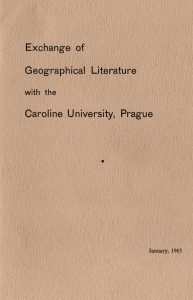
Exchange of Geographical Literature pamphlet, dated January, 1965. (Source: Papers of RH Osbourne, University of Nottingham)
Stylistically, as well as in terms of content, the map is of interest. The map has been designed to accentuate the economic and labour geographies of Czechoslovakia. It is does this effectively, by using a combination of bright, primary colours in the pie charts and by backgrounding the topography and political geography of the region. The size of the pie charts indicates industrial employment by settlement for all settlements with more than 50 residents and the different coloured wedges indicate the composition of industrial employment for each settlement, which can be examined on the zoomable image of the map below; the map key can be found in Footnote 1 at the end of this blog.
One can also see how difficult it is to pick out national boundaries, which can initially prove confusing as Czechoslovakia bordered both East and West Germany, Poland, the USSR, Hungary and Austria. The summary commentary on the reverse of the map is provided, in English and Russian, by the eminent Czech economic geographer, Prof. Dr. Miroslav Blažek who held positions as Head of the Department of Economic Geography at the University of Economics in Brno, before moving to head up the Economic Geography unit of the Czech Academy of Sciences (further biographical information can be found in Footnote 2 below).
In terms of content, the map itself is of significant interest to the economic geographer, as it depicts industrial employment by sector, based on data collected in 1960. This was the year in which the Constitution of the Czechoslovak Socialist Republic was ratified, serving to remove the more liberal aspects of the constitutions produced in 1920 and 1948. As such, it served to severely limit the federal autonomy of Slovakia, subsuming Slovakia to a more centralised form of government based in Prague. Before returning to the relevance of this, is it useful to reflect on the map from a general perspective.
The main map clearly shows a concentration of industrial employment in the key population centres of Prague, Brno and Plzeň, specialising in the production of machinery (coloured red) and on the Northern Bohemian border (near Chomutov and Most) and Ostrava, focusing on coal and lignite extraction. As can be seen, in Slovakia (South and East of the main map) there is significantly less industrial employment, aside from in Bratislava and the towns of Martin, Trencín and Košice in the far East. This is perhaps unsurprising given that Slovakia was a traditionally agrarian economy and, in 1960, only accounted for c.18% of Czechslovakian industrial employment. Indeed, writing in 1954, Harriet Wanklyn noted, in somewhat peremptory fashion that, “Slovakia is industrially backward” (Wanklyn, 1958: 297). The current border between the Czech and Slovak Republics runs diagonally, South West to North East, from the town of Břeclav near the Austrian border in Southern Moravia, to just North of the town of Čadca on the Slovak-Polish border.
Following the ratification of the 3rd constitution in 1960, Slovakia was subject to an acceleration of investment in heavy industry, particularly in terms of arms and armaments centred around the ‘explosive triangle’ of Martin, Považská Bystrica and Dubnica nad Váhom. This was a key aspect of Soviet style industrial policy – attempting to eradicate capitalist uneven development through direct state intervention in industrial strategy. Such a policy also continued in Bohemia and Moravia (the Czech lands), especially around industrial hubs such as Ostrava, where ambitious new housing projects situated in new towns and suburbs were created to house residents working in coal mining and manufacturing, as shown in photographs within the R.H. Osborne papers here.
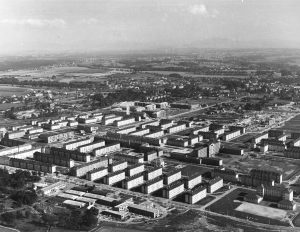
Newly Constructed Housing for Miners, Karviná, Ostrava, early 1960s (Source: Papers of RH Osborne, School of Geography, University of Nottingham)
These urban landscapes are characteristic features of developments in towns and cities throughout Eastern Central Europe that were instigated during the 1960s. The development of so-called panelák (panel, or prefabricated) housing during this period was an attempt to provide cheap and effective housing for towns experiencing rapid industrialisation and population growth.
The relative, so-called, ‘backwardness’ of the Slovakian territories noted previously, in terms of industrial development, is reflected on further by Blažek, who notes, “…[the] last vestiges of an uneven industrial development are gradually being eliminated”. The perceptions of such ‘backwardness’ were vital in the justification of various industrialisation programmes that were rolled out in Slovakia. These regional disparities can be seen in the inset map reproduced below, showing the ‘Degree of Regional Industrialisation’ of Czechoslovakia. The level of intensity of the coloured circles is designed to indicate the number of workers per 1,000 residents and the colour of each region denotes the number of workers per 10km2. As can be seen, in the Slovak lands, industrial workers are a smaller percentage of the population and industrial employment is less strongly concentrated.
Such processes were a central pillar of a number of economic plans instigated in the post-Stalinist period from 1956 onward and were strongly linked to the Cold War military-industrial complex supporting the militarisation and power projection of the USSR on the world stage. The forced industrialisation of Slovakia had significant impacts on the social and economic geography of the future Slovak Republic and by 1988, almost 30% of industrial employment in Czechoslovakia was based in Slovakia, a doubling of employment since 1948.
Following the collapse of state socialism and centralised economic planning between 1989 and 1993 that expedited the shedding of labour from uncompetitive (and newly privatised) industrial enterprises alongside concomitant failures to create new enterprises, Slovakia suffered significantly. The relative reliance of Slovakia on heavy engineering and armaments manufacturing and the strong links between the economy and CMEA (Council for Mutual Economic Assistance) meant that the collapse in demand for products impacted Slovakia more than the Czech Republic. By the mid-1990s some Slovak regions experienced unemployment rates of over 20% and employment in industry fell by 22.6% nationally between 1990 and 1994. This decline was matched by similar declines in real wages. Such patterns were mirrored in historic industrial regions, such as Northern Bohemia, where coal production and employment fell by almost 50% between 1984 and 1994. Indeed, the uneven regional impacts of the transition to capitalism could well be seen as one of the contributing factors to the dissolution of Czechoslovakia, the so-called ‘Velvet Divorce’ of 1993.
The 1966 map of Czechoslovakia acts as a window into a skein of complex biographies, of the material ‘map itself’ travelling across Europe as part of links developed between East and West, between Nottingham, Prague and Brno and as an artefact of central economic and industrial planning and the political formalisation of the State Socialist Constitution in 1960. Furthermore, the map can be used with a healthy dose of hindsight, to explore how changing industrial and economic imperatives and regimes of accumulation (Smith 1998) have had a significant impact on the actually existing economic geographies of the former Czechoslovakia.
Footnotes
[1] Key to Main Map
[2] Biographical Note: Prof. Dr. Miroslav Blažek (b. Brno, 1916 – d. Brno, 1983) was an eminent Czech economic geographer. His doctoral research was interrupted by the occupation of Czechoslovakia by Nazi Germany and was completed following the liberation of the Czech lands in 1945. It focused upon the settlement geographies of Northern Bohemia – a resource rich and geopolitically contentious region. His most influential publications were An Economic Geography of Czechoslovakia (1958) and Political and Economic Geography (1967). A review of the German translation of the former in the Geographical Journal from 1960 by Harriet Steers (nee Wanklyn; she married fellow geographer JA Steers in 1942 but published geographies of Eastern Europe under both her birth and married surnames) noted that, “Something of the distinguished Czechoslovak past in geography has been transmitted to readers of our own time”.
[3] I would like to thank Dr. Gary Priestnall for his support (and tolerance) in providing assistance with scanning the map.
References and Further Reading
Blažek, M. (1958) Hospodářský zeměpis Československa, Prague: Orbis
Heimann, M (2011) Czechoslovakia: The State that Failed, New Haven: Yale University Press
Matless, D., Oldfield, J. and Swain, A. (2007) Encountering Soviet Geography: Oral Histories of British Geographical Studies of the USSR and Eastern Europe 1945-1991, Social & Cultural Geography. 8(3), 353-372
Osborne, R.H. (1967) East-Central Europe: A Geographical Introduction to Seven Socialist States, London: Chatto and Windus
Pavlínek, P. (1998) Privatisation and the regional restructuring of coal mining in the Czech Republic after the collapse of state socialism, in Pickles, J. and Smith, A. M. (eds) Theorising Transition: The political economy of post-communist transformations, London: Routledge, 218-239
Pounds, N. J. G. (1958) The spread of mining in the coal basin of Upper Silesia and Northern Moravia, Annals of the Association of American Geographers, 48(2), 149-163
Smith, A. M. (1998) Reconstructing the Regional Economy: Industrial Transformation and Regional Development in Slovakia, Cheltenham: Edward Elgar
Steers, H. (1960) Review of Blažek, M (1959) Ökonomische Geographie der Tschechoslowakischen Republik, The Geographical Journal, 126(1), p76
Svoboda, J. and Stehlik, B. (1966) Atlas of the Czechoslovak Socialist Republic, Prague: Czechoslovak Academy of Sciences, Central Administration of Geodesy and Cartography, 58mp
Wanklyn, H (1954) Czechoslovakia, London: Phillip
No comments yet, fill out a comment to be the first

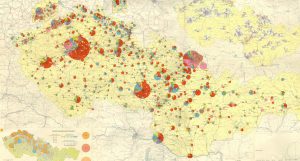
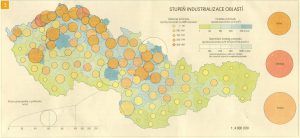
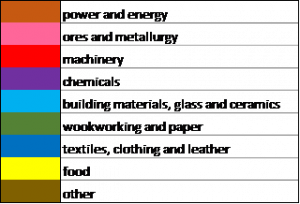
Leave a Reply